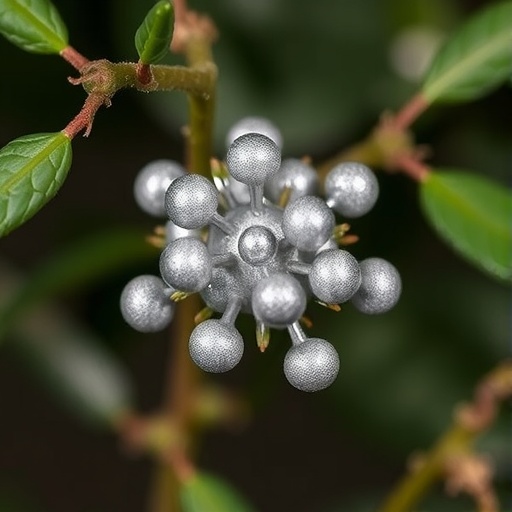The burgeoning field of nanotechnology continues to capture the imagination of researchers, particularly in the synthesis and application of nanoparticles. In a recent study, Patil et al. (2025) explore an innovative method for generating silver nanoparticles through an eco-friendly approach utilizing the natural resources of Cajanus cajan, commonly known as pigeon pea. This research represents a significant advancement in both sustainable practices and the potential applications of silver nanoparticles in various scientific fields, including medicine, electronics, and environmental remediation.
Nanoparticles, particularly silver nanoparticles (AgNPs), have garnered extensive attention due to their unique physical and chemical properties, which differ significantly from their bulk counterparts. These properties include high surface area-to-volume ratios, enhanced reactivity, and remarkable antibacterial effects. Silver nanoparticles are extensively employed in various domains, including biomedical applications, such as drug delivery systems and antimicrobial agents, owing to their remarkable ability to inhibit bacterial growth. However, traditional methods of synthesizing these nanoparticles often involve hazardous chemicals and environmentally detrimental practices.
The study conducted by Patil and colleagues highlights a breakthrough as it employs Cajanus cajan pods—biowaste from agricultural processes—as a natural reducing agent to synthesize silver nanoparticles. This innovative approach not only addresses the growing concern over chemical waste but also supports a circular economy by repurposing agricultural waste materials. The utilization of natural extracts in nanoparticle synthesis aligns well with the principles of green chemistry, emphasizing sustainability and environmental responsibility.
The synthesis process outlined in the study involves extracting phytochemicals from the Cajanus cajan pods, which serve to reduce silver ions to form silver nanoparticles. The researchers meticulously detail the parameters influencing the synthesis, including temperature, pH, and concentration of the precursor solution. The characterization of these nanoparticles is equally critical and is accomplished through a spectrum of analytical techniques, including UV-Vis spectroscopy, scanning electron microscopy (SEM), and transmission electron microscopy (TEM). These methods provide insights into the size, shape, and distribution of the nanoparticles formed.
One of the standout findings of the study is the biosynthetic potential of Cajanus cajan pods, which contain a myriad of bioactive compounds such as flavonoids and phenolic acids. These compounds not only act as reducing agents but also stabilize the synthesized nanoparticles, preventing them from aggregating. The research demonstrates that the natural synthesis process yields nanoparticles with a spherical morphology and a size range conducive to various applications, further emphasizing the versatility of green synthesis methods.
In addition to synthesizing silver nanoparticles, the researchers conducted a thorough assessment of the cytotoxicity of the particles generated. Understanding the toxicity levels of synthesized nanoparticles is essential for their safe application in biological systems. The study investigated the effects of these nanoparticles on human cell lines, revealing that the cytotoxic effects were both concentration and time-dependent. Such rigorous evaluations are crucial for establishing safe dosage levels and paving the way for future biomedical applications where silver nanoparticles could be employed.
The implications of this research are both profound and far-reaching. The green synthesis of silver nanoparticles using Cajanus cajan pods represents a promising alternative to conventional methods. By harnessing agricultural by-products, researchers can contribute to sustainable practices while simultaneously addressing the global challenge of waste management. This novel approach not only yields effective nanoparticles but also promotes the utilization of eco-friendly resources, aligning with the growing global emphasis on sustainability.
Furthermore, the findings from Patil et al.’s research could lead to advancements in the field of nanomedicine, particularly in the development of targeted drug delivery systems. Silver nanoparticles are known for their ability to enhance the bioavailability of therapeutic agents, and when combined with biocompatible materials, they could provide new avenues for cancer treatment or antibacterial therapies. The potential for these nanoparticles to interact with biological systems at the cellular level opens the door to innovative solutions in the fight against microbial resistance and various diseases.
Moreover, the versatility of silver nanoparticles extends beyond healthcare. Their unique properties enable applications in agricultural practices, such as improving soil health and promoting plant growth by acting as natural pesticides. The research illustrates how green synthesis methods can lead to breakthroughs that not only contribute to human health but also enhance agricultural productivity and sustainability.
As the field of nanotechnology continues to evolve, the significance of eco-friendly synthesis methods cannot be overlooked. The research conducted by Patil and colleagues serves as a compelling example of how traditional waste materials can be transformed into valuable nanoparticles through a process rooted in sustainability. The findings emphasize the urgent need for interdisciplinary approaches that combine scientific research, environmental stewardship, and agricultural innovation to pave the way for a greener future.
In conclusion, the study by Patil et al. underscores the transformative potential of using natural resources such as Cajanus cajan for the eco-friendly synthesis of silver nanoparticles. By addressing both environmental concerns and advancing scientific knowledge, this research sets a notable precedent for the future of nanoparticle synthesis, encouraging further investigations into other biowaste materials. The implications of this work extend into numerous fields, urging scientists and industries alike to embrace sustainable practices that benefit both humanity and the planet.
The frontier of nanotechnology remains bright as researchers continue to seek innovative solutions to pressing global challenges. The synergy of sustainable practices and advanced scientific exploration represents a fundamental shift in how we approach the development of new materials, particularly in the realm of nanotechnology. As we move forward, embracing and expanding upon these eco-friendly methodologies will be crucial in cultivating a more sustainable and healthier world.
Subject of Research: Green synthesis of silver nanoparticles utilizing Cajanus cajan pods.
Article Title: Cajanus cajan pods assisted green synthesis of silver nanoparticles and assessment of their cytotoxicity.
Article References:
Patil, S.P., Chaudhari, R.Y. & Nemade, M.S. Cajanus cajan pods assisted green synthesis of silver nanoparticles and assessment of their cytotoxicity.
Sci Nat 112, 57 (2025). https://doi.org/10.1007/s00114-025-02006-x
Image Credits: AI Generated
DOI: https://doi.org/10.1007/s00114-025-02006-x
Keywords: Silver nanoparticles, green synthesis, Cajanus cajan, biotechnology, nanotechnology, cytotoxicity, sustainable practices.




